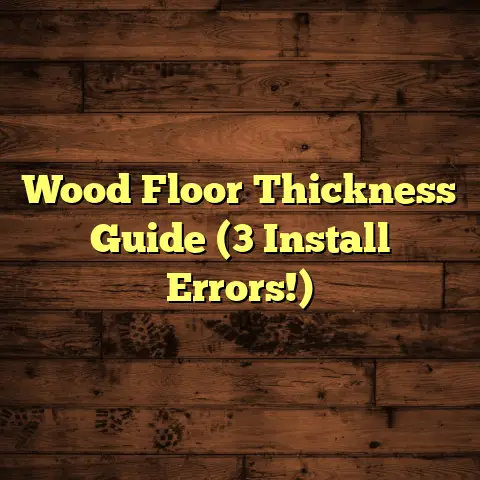Heated Floors Under LVT? (4 Install Must-Knows!)
Imagine this: It’s a biting winter morning. The kind where the world outside is crisp and unforgiving.
You swing your legs out of bed, expecting that familiar shock of cold tile, but instead…
Warmth.
A gentle, inviting heat radiates up, embracing your feet.
A soft glow kisses the room as the sun begins to rise. The air is still chilly, but the floor beneath you is an oasis.
That, my friend, is the magic of heated floors under luxury vinyl tile (LVT).
And in this article, I’m going to give you the lowdown on how to make that dream a reality.
As a flooring contractor with years in the trenches, I’ve seen it all.
I know the triumphs and the pitfalls of installing heated floors under LVT.
So, let’s dive in.
Understanding Heated Floors and LVT
Let’s start with the basics. What exactly are we talking about here?
What are Heated Floors?
Heated floors, simply put, are systems that radiate heat from the floor upwards.
This creates a more even and comfortable temperature throughout the room compared to traditional forced-air heating.
There are two main types:
-
Electric Systems: These use electric cables or mats installed under the flooring to generate heat. They’re relatively easy to install, making them a popular choice for smaller areas.
-
Hydronic Systems: These circulate warm water through pipes embedded in the subfloor. They’re more energy-efficient for larger areas but require a more complex installation.
Which one is right for you? We’ll get to that.
Luxury Vinyl Tile (LVT): The Rising Star
LVT has exploded in popularity, and for good reason.
It’s durable, waterproof, relatively inexpensive, and comes in a huge array of styles that mimic everything from hardwood to stone.
According to a report by MarketWatch, the global luxury vinyl tile market is expected to reach \$43.59 billion by 2028. (Source: MarketWatch)
That’s huge!
LVT is also relatively thin, which is a bonus when pairing it with heated floors. Why? Because you want the heat to transfer efficiently, and thick flooring can act as an insulator.
The Perfect Pair?
So, can you put heated floors under LVT?
Absolutely! But it’s not as simple as slapping down some heating elements and calling it a day.
The key is understanding the compatibility and following the right installation procedures.
When done correctly, heated floors under LVT offer a trifecta of benefits:
- Comfort: Say goodbye to cold feet!
- Energy Efficiency: Radiant heat is more efficient than forced air, potentially saving you money on your energy bills.
- Versatility: LVT’s wide range of styles means you don’t have to sacrifice aesthetics for comfort.
Now, let’s get into the nitty-gritty.
Must-Know #1: Choosing the Right Heating System
This is where things get interesting.
The type of heating system you choose will significantly impact the performance and longevity of your heated LVT floor.
Here’s what you need to consider:
-
Installation Method: Some LVT is glued down, while others are floating (click-lock). This will influence the type of heating system you can use. Glue-down LVT generally works better with electric systems embedded in a self-leveling compound.
-
Thermal Conductivity: You want a system that efficiently transfers heat through the LVT. Electric systems tend to heat up faster, but hydronic systems offer more consistent heat over larger areas.
-
Flooring Thickness: Thicker LVT will take longer to heat up and may not be as efficient. Look for LVT specifically designed for use with radiant heat.
-
Manufacturer Recommendations: Always, always check the LVT manufacturer’s recommendations for compatible heating systems. This is crucial!
Examples of Well-Suited Products:
-
Schluter-DITRA-HEAT: This electric system is specifically designed for tile and stone, but it can also be used under LVT with the manufacturer’s approval. The uncoupling membrane also helps prevent cracks in the LVT.
-
WarmlyYours TempZone™ Flex Rolls: These electric mesh rolls are easy to install and provide even heat distribution.
-
Uponor Quik Trak: This hydronic system uses a thin profile panel that makes it suitable for retrofit installations.
Real-World Example:
I once worked on a project where the client insisted on using a thick, high-end LVT that wasn’t recommended for radiant heat.
We tried to dissuade them, but they were adamant.
The result? The floor took forever to heat up, and the system consumed a ton of energy.
Eventually, they had to replace the LVT with a thinner, more suitable option.
Learn from their mistake!
Must-Know #2: Preparing the Subfloor
This is where the magic truly happens.
A properly prepared subfloor is the foundation of any successful heated floor installation.
Think of it like this: If your subfloor is a mess, your heated floor will be a mess, too.
Here’s what you need to do:
-
Moisture Testing: Excess moisture is the enemy of LVT and can damage the heating system. Use a moisture meter to check the subfloor’s moisture content. It should be within the LVT manufacturer’s specified range.
-
Leveling: An uneven subfloor will create hot spots and cold spots in your heated floor. Use a self-leveling compound to create a perfectly flat surface.
-
Insulation: Insulation is key to maximizing heating efficiency. Without it, heat will escape downwards, wasting energy and money.
According to the U.S. Department of Energy, insulating your floors can save you up to 10% on your heating bills. (Source: U.S. Department of Energy)
Step-by-Step Instructions for Common Subfloor Types:
-
Concrete:
- Clean the concrete thoroughly to remove any dirt, debris, or adhesive residue.
- Repair any cracks or holes with a concrete patching compound.
- Apply a moisture barrier if necessary.
- Pour a self-leveling compound to create a flat surface.
- Install insulation boards on top of the leveled concrete.
-
Plywood:
- Inspect the plywood for any signs of damage or rot. Replace any damaged sections.
- Fasten the plywood securely to the joists.
- Sand down any uneven areas.
- Apply a layer of plywood underlayment if necessary.
- Install insulation between the joists.
Tools Required:
- Moisture meter
- Self-leveling compound
- Level
- Trowel
- Concrete patching compound (if needed)
- Sandpaper
- Insulation boards or rolls
Pro Tip: Don’t skimp on the subfloor preparation. It’s the most important step!
Must-Know #3: Installation Techniques
Alright, now we’re getting to the fun part: actually installing the heated floor.
This is where precision and attention to detail are crucial.
One wrong move, and you could end up with a system that doesn’t work properly or, worse, is unsafe.
-
Spacing the Heating Elements: Follow the manufacturer’s instructions carefully when spacing the heating cables or mats. Uneven spacing can lead to hot and cold spots.
-
Electrical Connections (for Electric Systems): Ensure all electrical connections are secure and properly grounded. Hire a qualified electrician if you’re not comfortable working with electricity.
-
Plumbing (for Hydronic Systems): Ensure all plumbing connections are leak-free. Pressure test the system before installing the LVT.
-
Embedding the Heating Elements: For electric systems, you’ll typically embed the heating elements in a thin layer of self-leveling compound. This helps distribute the heat evenly and protects the cables.
-
Installing the LVT: Once the heating system is installed and tested, you can install the LVT according to the manufacturer’s instructions. Be careful not to damage the heating elements during installation.
Following Manufacturer Guidelines and Local Building Codes:
This cannot be stressed enough.
Always follow the manufacturer’s guidelines for both the heating system and the LVT.
These guidelines are there for a reason: to ensure the system works properly, is safe, and doesn’t void any warranties.
Also, be sure to check your local building codes for any specific requirements related to heated floors.
Common Installation Pitfalls to Avoid:
-
Damaging the Heating Elements: Be extremely careful when handling the heating cables or mats. Avoid stepping on them or dropping heavy objects on them.
-
Using the Wrong Adhesive: Some adhesives can damage the heating elements or interfere with heat transfer. Use an adhesive specifically recommended for use with radiant heat.
-
Overheating the System: Don’t crank up the thermostat too high. Overheating the system can damage the LVT or shorten the lifespan of the heating elements.
Personal Experience:
I remember one job where the homeowner tried to install an electric heated floor themselves without reading the instructions.
They ended up overlapping the heating cables, which created a dangerous hot spot.
Luckily, we caught the mistake before they installed the LVT, but it could have been a disaster.
Must-Know #4: Testing and Maintenance
You’ve installed the heated floor, laid the LVT, and now it’s time to see if all your hard work has paid off.
Testing the system before you fully commit is crucial.
-
Testing the Heating System: Before installing the LVT, test the heating system to ensure it’s working properly. Use a multimeter to check the resistance of the heating cables. Turn on the system and monitor the temperature to ensure it’s heating evenly.
-
Monitoring and Adjusting Settings: Once the LVT is installed, monitor the system closely for the first few days. Adjust the thermostat settings to find the optimal comfort level.
-
Troubleshooting Common Issues: If the system isn’t heating properly, check the following:
- Electrical Connections: Make sure all connections are secure.
- Thermostat Settings: Ensure the thermostat is set correctly.
- Circuit Breaker: Check the circuit breaker to see if it has tripped.
- Heating Elements: Use a multimeter to check the resistance of the heating cables. If the resistance is outside the manufacturer’s specified range, the heating elements may be damaged.
-
Maintenance: Heated floors under LVT are relatively low-maintenance. However, it’s important to clean the LVT regularly to prevent dirt and debris from accumulating on the surface.
Long-Term Maintenance Tips:
-
Use a Doormat: Place a doormat at the entrance to your room to prevent dirt and debris from being tracked onto the LVT.
-
Clean Regularly: Sweep or vacuum the LVT regularly to remove dirt and debris.
-
Use a Mild Cleaner: Use a mild, pH-neutral cleaner specifically designed for LVT. Avoid using harsh chemicals or abrasive cleaners, which can damage the surface of the LVT.
-
Avoid Excessive Moisture: While LVT is waterproof, it’s still important to avoid excessive moisture. Wipe up spills immediately to prevent them from seeping into the seams.
-
Check for Loose Tiles: Periodically check the LVT for any loose tiles. If you find any, re-adhere them using a suitable adhesive.
Conclusion: Warmth Underfoot, Peace of Mind
So, there you have it: everything you need to know about installing heated floors under LVT.
It’s a project that requires careful planning, attention to detail, and a willingness to follow the manufacturer’s instructions.
But the rewards are well worth the effort.
Imagine stepping onto a warm, inviting floor on a cold winter morning.
Imagine the comfort and luxury that heated floors can bring to your home.
It’s an investment that will enhance your living space and make your home a true sanctuary.
And that, my friend, is priceless.
Now, go forth and create your own warm, cozy oasis!





